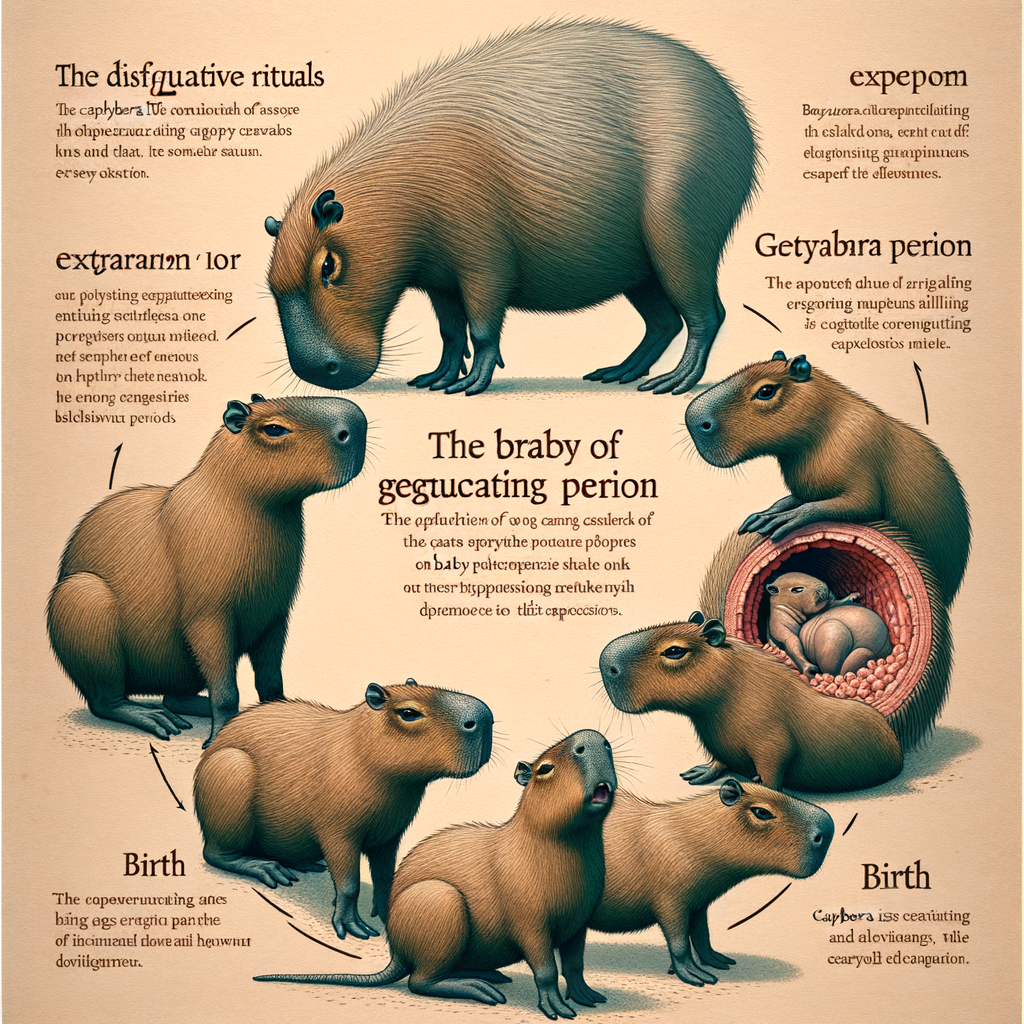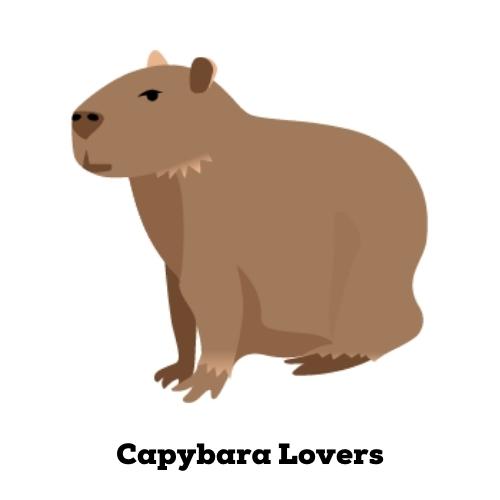
Introduction to Capybara Breeding
Welcome to the fascinating world of Capybara breeding! Capybaras, the world’s largest rodents, have unique breeding habits that are interesting to study and understand. In this article, we will delve into the Capybara reproduction cycle and their mating habits.
-
- Understanding the Capybara reproduction cycle
The Capybara reproduction cycle is a fascinating process. Female Capybaras, also known as does, reach sexual maturity at about 15 months of age, while males, or bucks, mature at around 18 months. The breeding season typically occurs during the rainy season, which provides ample food and water resources for the newborns.
After a gestation period of approximately 150 days, the doe gives birth to a litter of 1 to 8 babies, called pups. The pups are precocial, meaning they are well-developed and active from birth. They can swim and eat grass within hours of being born, although they continue to nurse from their mother for about 16 weeks.
-
- Overview of Capybara mating habits
Capybaras have a polygynous mating system, which means that a dominant male mates with multiple females. The dominant male, also known as the alpha male, defends his group of females from other males. He is usually the largest and strongest male in the group.
Interestingly, Capybaras mate in water, which is a unique trait among rodents. The water provides a safer environment for the female during mating and also helps to keep the pups safe from predators after birth.
In the following sections, we will delve deeper into the Capybara gestation period, the birth process, and the first few weeks of a baby Capybara’s life. Stay tuned to learn more about the miracle of Capybara birth!
The Capybara Reproduction Cycle
Understanding the capybara reproduction cycle is a fascinating journey. This process involves several stages, each with its unique characteristics and importance. Let’s delve into these stages and explore the wonders of capybara reproduction.
Stages of the Capybara Reproduction Cycle
-
- Initial Attraction and Courtship
The capybara reproduction cycle begins with attraction and courtship. Male capybaras, also known as boars, will often use vocalizations, scent marking, and physical displays to attract females, or sows. This initial stage is crucial for the formation of mating pairs.
-
- Mating and Conception
Once a female capybara has been successfully courted, the pair will mate. Mating usually occurs in water and can last for several minutes. After successful mating, conception occurs, marking the beginning of the gestation period.
-
- The Capybara Gestation Period
The gestation period in capybaras lasts about 130 to 150 days. During this time, the female capybara will carry her young in her womb. By the end of this period, she will be ready to give birth.
-
- The Capybara Birth Process
The birth process in capybaras is relatively quick and usually occurs without complications. A female capybara can give birth to 1 to 8 pups at a time, with an average litter size of 4. These pups are born fully furred and with their eyes open, ready to join the capybara community.
-
- Post-birth: Baby Capybaras and their Care
After birth, baby capybaras, also known as pups, are cared for by their mother and other adult females in the group. They start eating grass within a week of their birth but continue to nurse from their mother for about 16 weeks. This post-birth care is essential for the survival and growth of the pups.
In conclusion, the capybara reproduction cycle is a complex and fascinating process. It involves several stages, from initial attraction and courtship to post-birth care of the pups. Understanding this cycle provides valuable insights into the life and behavior of these remarkable creatures.
Capybara Mating Habits
Understanding the mating habits of the capybara, the world’s largest rodent, can be a fascinating study. These semi-aquatic mammals, native to South America, have unique reproductive behaviors that are influenced by various factors such as seasonal changes and dominance hierarchies.
Understanding Capybara Reproductive Behavior
Before we delve into the specifics of capybara mating, it’s important to understand their overall reproductive behavior. Capybaras are social animals, living in groups of 10 to 20 individuals. These groups are usually dominated by a single male, who has the primary right to mate with the females in the group.
-
- Seasonal changes and their impact on mating
Capybaras are seasonally reproductive, which means they mate at certain times of the year. The exact timing can vary depending on the region, but in general, capybaras breed during the rainy season. This is because the rainy season provides an abundance of food and water, which are essential for the survival and growth of the young capybaras. During this time, the dominant male mates with the females in the group, leading to the birth of young capybaras in the following dry season.
-
- Role of dominance in Capybara mating
In capybara groups, there is a clear dominance hierarchy. The dominant male, also known as the alpha male, has the primary right to mate with the females in the group. This dominance is established through various behaviors such as scent marking and vocalizations. The alpha male is usually the largest and strongest capybara in the group, and he maintains his dominance by fighting off challenges from other males. This dominance plays a crucial role in capybara mating, as it ensures that the strongest genes are passed on to the next generation.
Understanding the mating habits of capybaras can provide valuable insights into their behavior and social structure. It also highlights the importance of environmental factors such as seasonal changes in the life cycle of these fascinating creatures.
The Capybara Gestation Period
The gestation period, or pregnancy, of a capybara lasts approximately 130 to 150 days. This is the time from when the capybara mother becomes pregnant, to when she gives birth to her babies, known as pups. During this period, there are several changes that occur in the mother capybara, both physically and behaviorally.
Changes During Capybara Pregnancy
Just like humans, capybaras also undergo significant changes during pregnancy. These changes help prepare the mother for the birth of her pups and ensure their survival. Let’s look at these changes in detail.
-
- Physical changes in the pregnant Capybara
As the pregnancy progresses, the mother capybara’s body undergoes several physical changes. The most noticeable change is the increase in size. Her abdomen swells as the pups grow inside her. The mother may also gain weight during this period. This is a natural process and helps ensure the healthy development of the pups.
-
- Behavioral changes during Capybara pregnancy
Along with physical changes, the mother capybara also experiences behavioral changes. She may become more protective and cautious of her surroundings. This is a natural instinct to protect her unborn pups. The mother may also spend more time resting and less time foraging for food as her pregnancy progresses. This behavior helps conserve energy for the birth process.
In conclusion, the capybara gestation period is a fascinating process, filled with changes that ensure the survival and health of the pups. Understanding these changes can help us better appreciate the complexity and beauty of nature.
The Capybara Birth Process
The birth process of a capybara is a fascinating journey. It is a unique event that showcases the beauty of nature and the cycle of life. In this section, we will explore the capybara birth process, from the signs of impending birth to what to expect during the actual birth.
From Pregnancy to Birth: The Capybara Life Cycle
Understanding the capybara life cycle, from pregnancy to birth, is essential for anyone interested in these fascinating creatures. Let’s take a closer look at the key stages.
-
- Signs of impending birth in Capybaras
As the birth of a capybara approaches, there are several signs to watch out for. The female capybara, also known as a sow, may become restless and start to nest. She may also show signs of discomfort due to the growing size of her litter. These signs usually occur a few days before the birth.
-
- The birth process: What to expect
The birth process in capybaras is usually quick and efficient. The sow will find a safe, secluded spot to give birth. The newborn capybaras, known as pups, are born fully furred and with their eyes open. They are able to follow their mother and start eating solid food within hours of birth, although they will continue to nurse for several weeks.
Now that we have a better understanding of the capybara birth process, we can appreciate the remarkable journey these creatures go through from pregnancy to birth. It’s a testament to the wonders of nature and the resilience of these amazing animals.
Baby Capybaras: The First Few Weeks
The first few weeks of a baby capybara’s life are crucial. These adorable creatures require special care and attention to ensure they grow up healthy and strong. Let’s delve into the details of newborn capybara care.
Capybara Newborn Care
Caring for a newborn capybara involves two main aspects: feeding and nurturing, and monitoring for common health concerns. Let’s explore each of these in detail.
-
- Feeding and nurturing Baby Capybaras
Feeding a baby capybara requires a balanced diet of fresh grass, hay, fruits, and vegetables. It’s essential to provide plenty of fresh water as well. Nurturing involves creating a safe and comfortable environment for the baby capybara. This includes providing a warm and dry place to sleep, and plenty of space to explore and play.
-
- Common health concerns in newborn Capybaras
Like all newborn animals, baby capybaras can be susceptible to certain health concerns. These may include respiratory issues, digestive problems, and skin conditions. It’s vital to monitor the baby capybara’s health closely during the first few weeks and seek veterinary care if any issues arise.
In conclusion, the first few weeks of a baby capybara’s life are a critical time. With proper feeding, nurturing, and health monitoring, these adorable creatures can grow up to be healthy and happy adults. Remember, the key to successful capybara care is patience, attention, and love.
Conclusion: The Miracle of Capybara Birth
As we reach the end of our journey exploring the fascinating world of capybara reproduction, we can’t help but marvel at the miracle of capybara birth. This process, though common in the animal kingdom, holds a unique charm when it comes to capybaras. Let’s recap the key points we’ve learned and understand why capybara breeding is so essential for the survival of the species.
-
- Key takeaways from the Capybara reproduction cycle
The capybara reproduction cycle is a fascinating process that begins with mating, followed by a gestation period of about 150 days. The female capybara gives birth to a litter of 4-5 babies, known as capy pups. These pups are born fully developed, with their eyes open and a full coat of fur. They are capable of joining the herd and even swimming within hours of birth, which is a remarkable feat in the animal kingdom.
-
- Understanding the importance of Capybara breeding for species survival
Capybara breeding is crucial for the survival of the species. With capybaras being a key part of the food chain, their population numbers significantly impact the ecosystems they inhabit. Their breeding habits ensure a steady population growth, which helps maintain a balance in their natural habitats. Furthermore, capybaras play a vital role in dispersing seeds in their environment, contributing to the growth and diversity of plant life.
In conclusion, the capybara reproduction cycle is a testament to the wonders of nature. From their unique mating habits to the miracle of birth, every stage is a marvel in itself. By understanding and appreciating these processes, we can better appreciate the capybaras and the crucial role they play in maintaining ecological balance.













